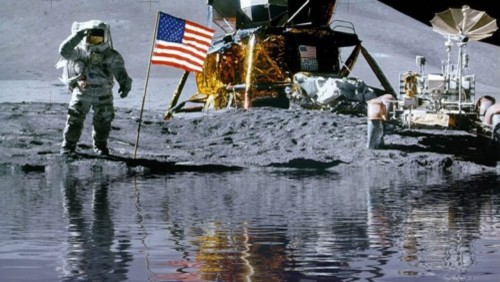In the images sent back by Apollo 11, the moon looked like an airless wasteland. But like the Earth, the moon also has water, as well as hydrated minerals called hydroxyl. This abundance of hydrogen could have been delivered in a myriad of ways. During the formation of the Earth and the Moon, a water delivery system was created from comets and asteroids impacting the surface, and from the interaction of sunlight with hydrogen molecules on the lunar surface.
While scientists know that the Moon is covered with a variety of hydrogen, they are unclear about exactly how much water is on the Moon, or even where it is located. Missions that have orbited the Moon have done basic surveys but have so far been unable to provide full clarification. When NASA’s SLS rocket launches in the near future, its payload will include a cubesat — a tiny satellite — called LunaH-Map that will begin to map the water around the Moon.
So let’s say in 10 years, scientists have a complete understanding of where the hydroxyl and H2O are located. What can be done with that water?
It’s not just for drinking. There’s a concept in space exploration called "In Situ Resource Utilization," or ISRU, which basically means going to a place and utilizing the materials that are already there. Water on the Moon can be used to make rocket fuel, as well as help shield spacecraft from radiation exposure. And NASA is not the only organization that wants to know where all the hydrogen is hiding — many private companies have plans to grow full-fledged businesses out of lunar rocket fuel, potentially even selling water to NASA for long-duration trips to space.
Once researchers locate water on the Moon, the next step is mining it. That’s easy enough on Earth, but it has never been done in space. "While we know how to extract these components on Earth, a huge unknown is how to do this with lunar regolith," the unconsolidated dust and rock atop the lunar surface, says Debra Needham, a planetary scientist at NASA’s Marshall Space Flight Center.
Plans are in the works, however. "There are two basic concepts on how to extract the water from the Moon," says Phil Metzger, a planetary scientist at the University of Central Florida. "One concept is that you scoop up the soil and you carry it back to a processing plant. At the processing plant you melt the ice or vaporize the ice with heat and you get [water] out from the soil grains and then you refreeze it."
This first method — called "thermal mining" — is technically more complicated and requires more infrastructure, which means it is more costly. Another method goes by the name "mechanical mining." "You apply heat in situ and you get [water] to vaporize while it’s still in the ground, and you have to capture the vapors on top of the ground," says Metzger. "We’re making progress, but there’s too much uncertainty still about the thermal conductivity of the ice."
The water is also bound to other chemicals, and it’s not yet clear how future astronauts might separate out the water in its pure forms. "There are other elements strongly bonded to other minerals," says Needham. "So the mining companies basically need more information from the scientists before we can go through and know what techniques specifically to use."
Then there’s an additional complication: ethical considerations. How do we respect an environment that belongs to everyone? "We will be putting industry largely outside the social controls that we’ve evolved for 10,000 years," says Metzger. "So there’s going to be a degree of isolation between the industry and space and the people on the Earth trying to govern that."
Of course, one of the biggest hurdles to mining water on the Moon is actually getting to the Moon — the last time a human stood on the lunar surface was December 14, 1972, during the Apollo 17 mission. Many cubesats and smaller spacecraft are on the launch roster, however, and should be able to help map the location of water around the surface of the moon. If we first locate the craters with ice deposits and regions that contain more hydroxyl than H2O, then missions can be planned to visit those specific locations with the instruments needed for extraction.
While mining the moon might sound like a mostly commercial venture, both scientists and companies have a vested interest in digging into the lunar soil. By locating and studying the Moon’s water sources, it can not only set up long-term human exploration, but also provide answers to some of planetary science’s biggest questions.

The Earth and our moon are made of many of the same ingredients. We know that the moon was likely created out of material from our planet because we share the same isotopes, making us the solar system equivalent of fraternal twins. When the astronauts of Apollo 11 took off from Earth 50 years ago today, they were visiting a long-lost relative.




